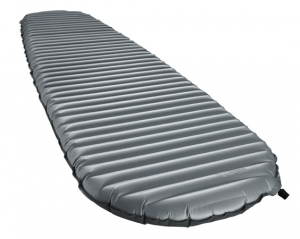Self-inflating mats
An air mattress is cold, an insulation pad hard. There had to be an alternative and that is what American Cascade Designs invented in 1973. Their concept has soon become world famous: you take a low open-cell foam and glue it on both sides with an air and waterproof cover with one opening closed by a valve. With the valve closed, the air cannot be squeezed when compressed, so that it stays insulated. If you open the valve, all air will be pushed out as you roll up the pad. This way a thick comfortable pad will also be reduced to a package that is smaller than a rolled up insulation mat. As you close the valve, the vacuum you created keeps the mat compressed and it is easily packed away into its pouch.
When the valve is reopened, the vacuum will fill itself (as vacuums are wont to do), sucking air in through the opened valve the foam regaining its original shape: enter the Therm-a-Rest they self- inflating mattress. The Seattle thinkers spoke about a ‘mattress’ from the beginning. The true strength of such a pad is not the self-inflating character (which does mean you don’t need a pump): the real revolution was the combination of isolation and comfort that most sleepers will appreciate.
Alternatives
Like any good idea, there are also other brands that have developed a variation on pads. Generally, cheaper alternatives though it must be said that this often is achieved by making concessions in materials selection, construction, and performance. Quality of foam and coating and the way these are bonded, quality of the valve, warranty and durability are some of the variables that differ widely.
If a manufacturer does not glue foam and lining completely or poorly, which is cost-effective, the foam is not sealed off completely. Air is allowed to circulate, resulting in poorer insulation. Such pads are self-inflating but forget the most important aspect of the mat; insulation.
There is a pad for every budget, but for something that is so essential for a good night’s rest, and through that for the success of your adventure, being too economical does not always seem to be a good choice.
As with many products the adagium “if you pay peanuts you get monkeys” is relevant in this case too.
 Sleeping pads do two things that are essential for a good night’s sleep. First, and most obvious, they provide a (relatively) soft surface to comfortably sleep on. Secondly, and more importantly, insulation gainst the cold ground. It does not make sense to invest in a pricey and warm sleeping bag if the substrate you are laying does not do what to do: isolate.
Sleeping pads do two things that are essential for a good night’s sleep. First, and most obvious, they provide a (relatively) soft surface to comfortably sleep on. Secondly, and more importantly, insulation gainst the cold ground. It does not make sense to invest in a pricey and warm sleeping bag if the substrate you are laying does not do what to do: isolate.

